____________________________________________________________________
1/8/25 UPDATE:
POINT REYES NATIONAL SEASHORE ANNOUNCES ELK FENCE REMOVAL AND PLAN TO PHASE OUT RANCHING
After years of sweat, tears, hard work, and fervent advocacy from wildlife enthusiasts, conservationists, concerned citizens, and public lands defenders alike, Point Reyes National Seashore has finally announced plans to remove its controversial elk fence, allow tule elk to self-manage their population, and begin to phase out ranching within the park. This largely unexpected announcement marks the beginning of a bright new era for the Seashore. Thank you to all who helped support this historic effort by contacting their local politicians, signing petitions, donating to campaigns, or simply spreading awareness. Read more about the park’s exciting announcement here.
____________________________________________________________________
6/4/24 UPDATE:
FINAL CHANCE TO SUBMIT COMMENTS TO THE PARK SERVICE!
The final public comment period closes WEDNESDAY, JUNE 5TH. I’ve drafted a template you can use to submit a comment directly to the park service showing your support for the elk – most of the work is already done for you. You can find that template and the submission link here.
____________________________________________________________________
8/28/23 UPDATE:
WE HAVE A CHANCE TO FREE THE TULE ELK!
Last week, for the first time ever, the park service announced that it is finally considering taking down the fence that has been responsible for hundreds of elk deaths.
Now is our chance to show the park service that we aren’t going anywhere until this deadly fence is gone! It is time the park service starts prioritizing essential native wildlife over private ranching profits.
The park has opened a 31-day public comment period, and I’ve drafted a letter template that you can use to submit a comment directly to the park service showing your support for the elk – all the work is already done for you! Just copy and paste, sign your name, and send off to the park service through their comment submission page. You can find that letter here.
If you would prefer to author your own comment, you can find the park’s public comment submission page here.
Let’s finally get these elk out of this cruel enclosure and onto the parkland they are rightfully entitled to!
____________________________________________________________________
Each year, over 2 million visitors from around the country flock to California’s Point Reyes National Seashore (PRNS), a renowned wildlife-watching, camping, and hiking destination for any nature-lover. This federally protected coastal peninsula is one of America’s most biodiverse regions; in fact it is so unique that it is designated by UNESCO (the United Nations Educational, Scientific, and Cultural Organization) as an international biosphere preserve. It is home to many threatened and endangered species, several of which are found only on the peninsula. It is also the only national park in the country where visitors can view California’s majestic tule (TOO-lee) elk, which were saved from the brink of extinction in the 1870s. Yet despite the park’s internationally-recognized wealth of biodiversity, a handful of privately owned ranches have had this publicly-funded national park and its beloved elk in a stranglehold for decades.
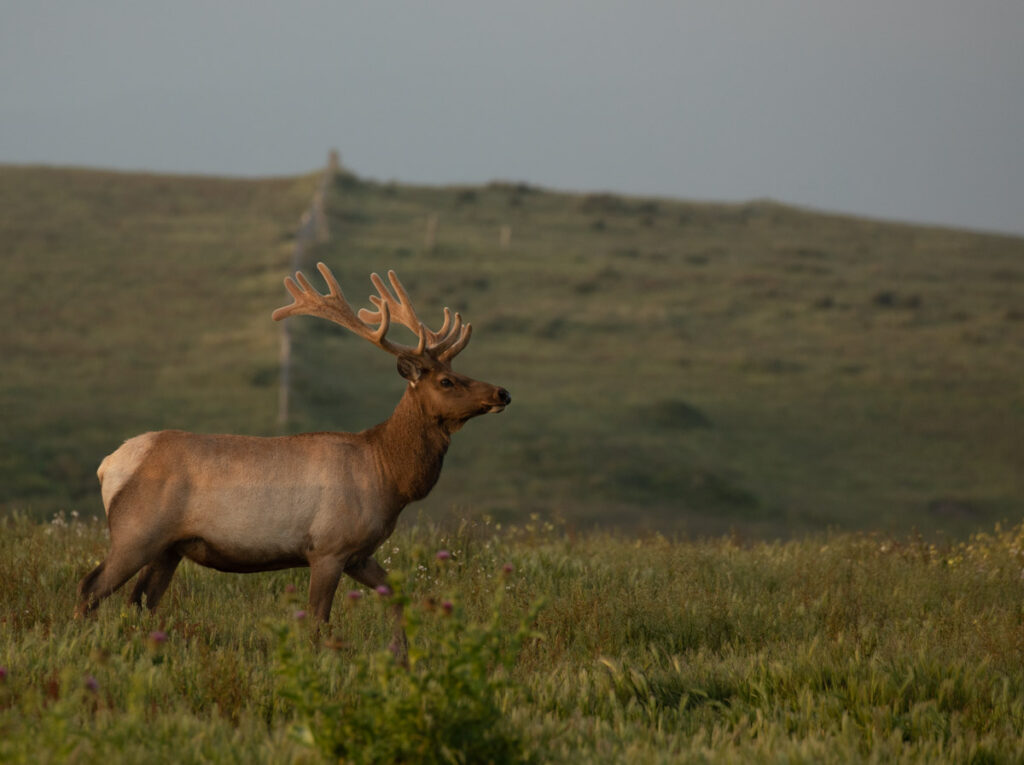
I will never forget the first time I drove out to Point Reyes in 2020. I knew very little about the park other than I was excited to spot some wildlife, including, hopefully, the tule elk. I distinctly remember driving along the park’s winding main road and gradually becoming more and more attuned to my sheer confusion at what I was seeing: cows. Dozens of them. Hundreds of them. Thousands of them. All across the landscape. Everywhere I looked, for as far as my eyes could see. And then, ranch houses. Dilapidated barns soaked in manure. Cattle guards on the road. Rusty holding pens. Fields of calf hutches. All just right alongside the road. Had I made a wrong turn? Was I on the wrong road? Where were the elk? This couldn’t be the renowned Point Reyes National Seashore. What was I missing?
A lot, it turns out. From federal lawsuits and heated protests to wildlife die-offs and cesspools of human feces, Point Reyes has a tumultuous history dating back to the 1800s. And while the park is certainly no stranger to controversy, tensions have never been higher than they are today.
CHANGING HANDS
Tule elk lived across most of California, including on the Point Reyes peninsula alongside the region’s Coast Miwok people, for thousands of years before the species was almost completely extirpated by 1870. They were presumed to be extinct until 1874, when a rancher named Henry Miller discovered the last few individuals on his ranch some 350 miles southeast of Point Reyes in the San Joaquin Valley. Over the next almost hundred years, a few small, isolated tule elk populations formed from the individuals found on Miller’s ranch, but ultimately conservation efforts floundered as poaching and habitat loss continued, along with several failed attempts at transplanting and establishing herds in other regions of the state. That is, until 1978, when 10 tule elk were relocated from the San Luis National Wildlife Refuge to Point Reyes National Seashore, establishing the Tomales Point Elk Herd. This transplant was and still is considered one of California’s greatest ecological success stories.
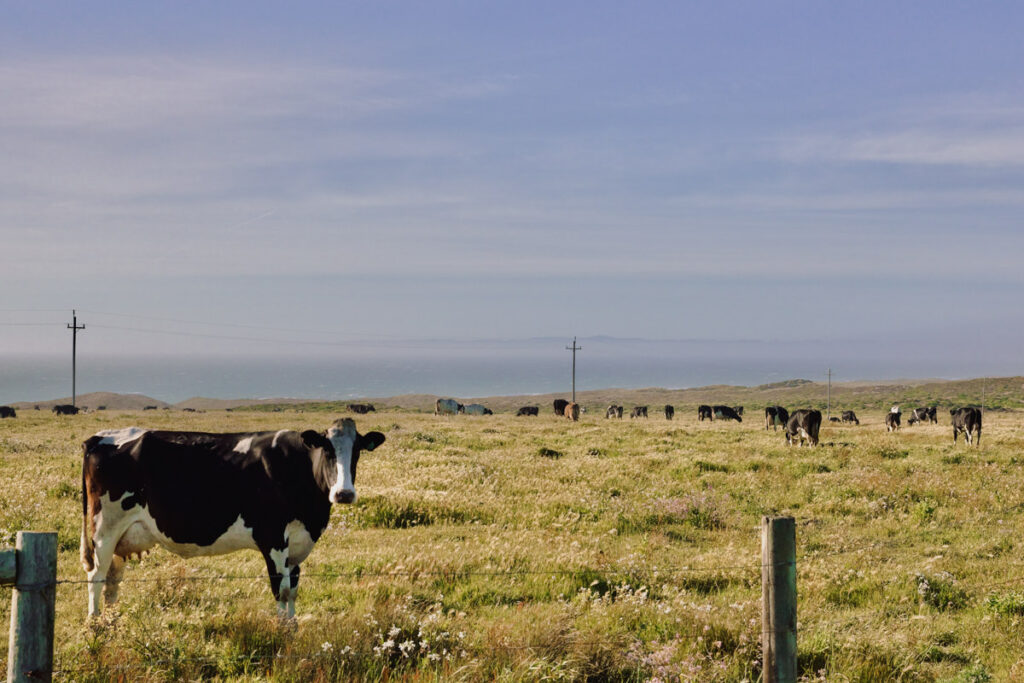
But not everyone was happy about this introduction. Back in 1850, settlers that came west with the gold rush set up shop on the appealing rolling hills of the Point Reyes peninsula to establish large-scale dairy and beef operations, many of whom played a large role in the eradication of the native tule elk, as they competed with cattle for resources. Then, almost a century later in 1956, the National Park Service (NPS) began to publicly express its desire to convert the Point Reyes peninsula to a national park. And in 1958, the park service published a report recommending the region’s immediate acquisition due to its biological uniqueness and the gradual phasing out of the region’s commercial cattle operations, thus triggering the park’s longstanding parkland-ranchland controversy. Environmentalists applauded the proposal while ranchers raged. In 1962, President John F. Kennedy signed off on establishing Point Reyes as a National Seashore, officially creating the park. Yet ranchers maintained private ownership of their ranchlands until 1972, when the NPS paid a whopping $50 million (what would be over $370 million today) to finally acquire full ownership of all the cattle land within the park. The compromise, however, included that the NPS continue to lease these lands to the ranchers at well below market rates for no longer than the next 30 years. When these leases expired, the park’s cattle operations successfully lobbied to be allowed to remain in the park, and have been repeatedly granted renewed leases.
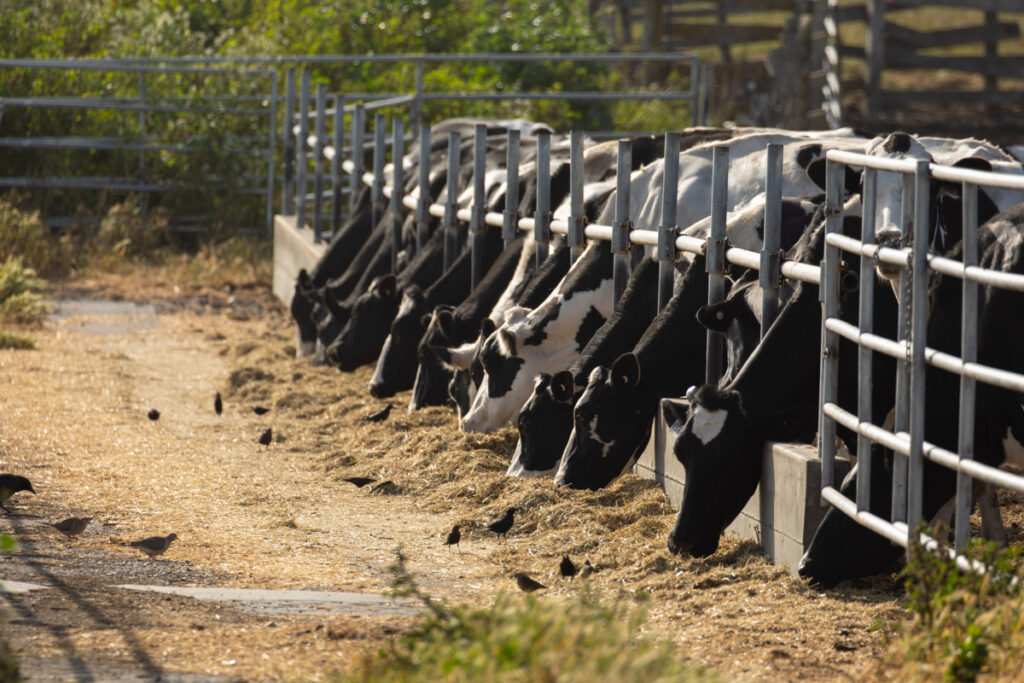
By 1992, the park’s elk population had grown significantly, and ranchers and park staff expressed concern about the elk’s numbers. It was at this point when the NPS introduced its first Elk Management Plan to keep the population “in check” by shooting a certain number of elk each year. Public outrage and the activism of local environmental organizations was enough to force the NPS to shelve the plan. And in 1998, a new management plan was created that did not include culling of the elk. The new plan involved relocating some of the elk from the Tomales Point Herd to form the new Limantour Herd. Eventually several individuals broke off again to form the third and final herd, the Drake’s Beach Herd. Beginning in the 1990s, the ranches and dairies within the park were repeatedly granted the ability to stay and continue operations by the NPS on what seemed to be a perpetually out of reach expiration date, all while the elk herds grew and stabilized at several hundred individuals. Pressure from ranchers to control the elk population continued to escalate.
AN IMPRISONED HERD
This brings us to the first major die-off. In the 2010s, California experienced its worst drought in recorded history, and while all three of the park’s elk herds were affected by dehydration and lack of adequate forage, the Tomales Point Herd fared the worst by far. By 2014, over half (about 250 individuals) of the Tomales Point Herd had perished.
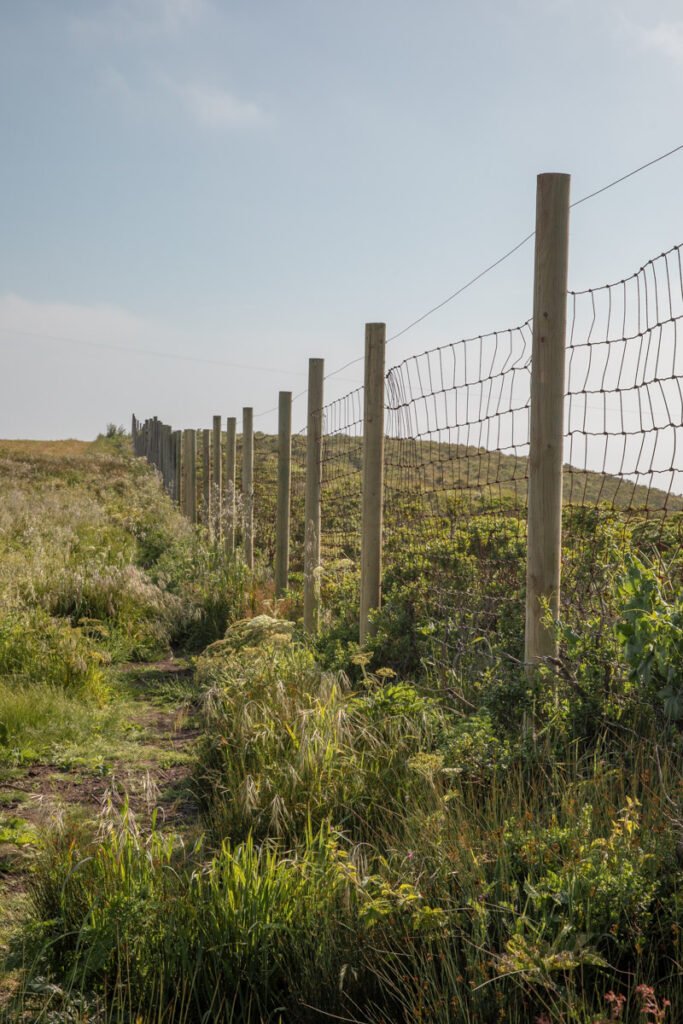
The reason for this particular herd’s disproportionate misfortune?
Simply put, the Tomales Point Herd is captive. Unlike the other two herds, the elk at Tomales Point live in a designated “reserve” where three miles of eight foot tall fencing restricts the herd into an enclosure, keeping them from competing for resources with the surrounding commercial beef and dairy operations and appeasing disgruntled ranchers who fought the elk reintroduction decades ago. Though most of the natural water and food sources in the reserve had completely dried up by 2014 and the desperate elk couldn’t cross the 8-foot high fence to find alternate food and water, the park service did nothing to intervene, saying the mass die-off was a natural phenomenon. The Tomales Point Herd’s numbers dropped from 540 individuals in 2012 to 286 individuals by 2014.
Shortly afterwards, a group of three environmental organizations (Center for Biological Diversity, Resource Renewal Institute, and Western Watersheds Project) sued the park for not complying with the National Environmental Policy Act (NEPA). The parties eventually settled on an agreement for the park to establish an Environmental Impact Statement (which was not previously required of ranchers) and to include alternatives to the proposed management plan. And in 2019, the park introduced its revised General Management Plan (GMP) with a series of alternatives, including Alternative B, in which the most significant change from the original proposal was its name. It outlined the expansion of ranching leases from 5 years to 20 years and would allow for the introduction of additional commercial domestic animals such as pigs, goats, and chickens on the ranches. But most notably, the alternative took aim at the tule elk once again. It called for the culling of the free-roaming Drake’s Bay Herd, arbitrarily capping the herd’s numbers at 140 individuals, and would also allow the park service to shoot any elk that strayed from their herd or were deemed a nuisance to the ranches. During the proposal’s public comment period, nearly 7,000 people wrote to express their dire concern for the elk and lack of support for the ranching operations. Conversely, just 179 individuals (a mere 2% of commenters) expressed support for the ranches.
But despite overwhelming public dissent, Alternative B was adopted and signed by the NPS. The California Coastal Commission (CCC) narrowly approved the new GMP by a 5-4 vote on the condition that the NPS develop a strategy for improving water quality in the park, a response to the park service having halted its requirements for ranches to monitor and maintain water pollution levels around their ranches back in 2013. Meanwhile, numerous reports of dangerously high water pollution levels continued to be released over the years by other various entities. A Coastal Watershed Assessment conducted by the NPS itself found that the peninsula’s waterways and coastlines were heavily polluted by blooms of E. coli directly fueled by cattle dung.
The drought of 2020 and 2021 brought about the second major Tomales Point Herd die-off: over a third of the herd died in 2020 (about 150 individuals), while the two other herds remained stable. (The Limantour Herd declined slightly from 164 to 155 individuals while the Drake’s Beach Herd increased from 138 to 139 individuals.) 72 more elk died in 2021. In less than two years’ time, over half of the Tomales Point Herd perished. Again, the other two herds remained stable at 169 and 151 elk, respectively.

Alternative B still has not been implemented due to legal and logistical delays, so for the time being the park’s ranches have been issued two-year interim leases. The latest population estimates are 262 elk in the Tomales Point Herd, 169 elk in the Limantour Herd, and 170 elk in the Drake’s Beach herd. There are currently over 5,500 cattle in the park.
SECOND-CLASS UNGULATES
Activists, county residents, park goers, and concerned citizens urge that the elk fencing should be removed and the park start prioritizing the survival of the native, threatened tule elk over the park’s cattle. The park has always maintained its position that the elk die-offs are simply a natural phenomenon caused by a growing population of elk. And while it is true that any population that exists within a finite space has a certain carrying capacity, activists argue that there is nothing “natural” at all about containing wild animals behind a fence without adequate resources for survival, especially while thousands of cattle roam and graze freely just on the other side of the fenceline.
Recent years have yielded dozens upon dozens of park visitors’ and concerned citizens’ photos, posts, and reports that have revealed undeniably nightmarish conditions for the park’s elk – what the Sierra Club has called “inhumane and unacceptable.” Sources show desperate elk attempting to drink from cattle troughs only to be hazed away by ranchers (a legal practice), crusty, dried up “ponds” that the park calls drinking water sources, elk entangled and deceased in fencing, and skeletons of elk who perished attempting to drink out of mud pits.
In recent years, the park has also condemned dozens of activists who have organized emergency drinking water deliveries for the elk. On several occasions, activists have breached the eight foot tall fence to carry in hundreds of gallons of emergency drinking water in troughs for the thirsty Tomales Point Herd. The park has always immediately removed the troughs, however, calling them an “environmental hazard” as they could crush the park’s endangered plants, and again stating that the elk had sufficient water sources. Ironically, though, in 2021, the park quietly and suddenly began providing supplemental water sources for the elk, though it continues to maintain its stance that lack of drinking water has never been a factor in the die-offs.
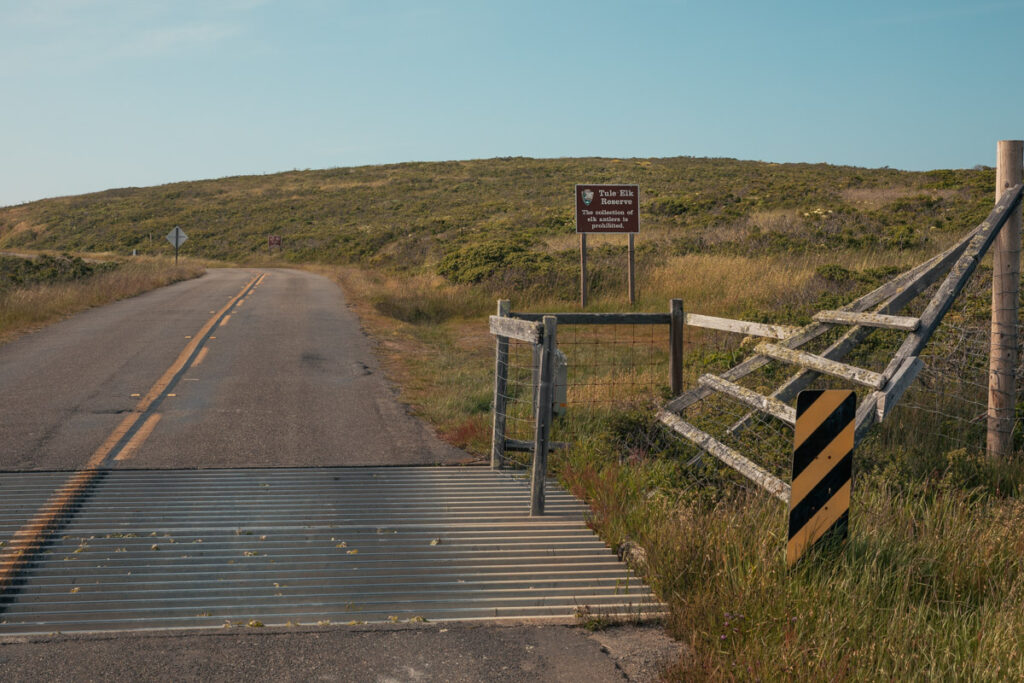
And while the Tomales Point Herd has been disproportionately affected, the other two herds also face serious challenges to survival. Though both the Limantour and Drake’s Beach Herds are technically “free-roaming,” individuals often struggle to cross miles and miles of ranches’ barbed wire fencing, are regularly hazed away from water and food sources by ranchers in vehicles and on horseback wanting to hoard the park’s resources for their cattle, and also face the prospect of culling. But the elk aren’t the only species threatened by the ranching.
FROM COASTAL PRAIRIE TO COASTAL DAIRY
Considering the relatively humble size of the park – just over 100 square miles (for comparison, Yellowstone is almost 3,500 square miles) – its ecological resume is shockingly impressive. Over 45% of Northern America’s bird species and nearly 20% of California’s plant species can be found within Point Reyes National Seashore. Thirty federally listed threatened and endangered species of animals and six federally listed threatened or endangered species of plants also exist within the park. Many species are endemic to the park, meaning Point Reyes is the only place they exist. The peninsula is considered to be one of the most unique and bountiful ecological regions in the country. Ranchers, politicians, and NPS spokespeople claim that the cattle are a necessary ecological component of the park and help to form the region’s striking and unique natural landscape. Science disagrees.

For thousands of years, tule elk and the region’s native grasses evolved alongside one another, perfecting their unique and symbiotic coexistence. The particular way the elk have evolved to graze on the coastal prairie’s native perennial bunchgrasses helps perpetuate the plants’ continued survival by protecting their roots and spreading their seeds. After the elk were reintroduced to Point Reyes in the 70s, maps of the area revealed a revival of native vegetation growth and the reduction in harmful invasive and nonnative plants. This is still true today: the Tomales Point reserve, where cattle do not graze, boasts a myriad of native coastal prairie species.
Years of environmental impact studies, water quality reports, and wildlife surveys within the park have shown disturbing yet unsurprising levels of ecological destruction as a direct result of the park’s beef & dairy operations. Cattle grazing zones within the park are now dominated by nonnative Eurasian annual grasses, invasive thistles, and toxic weeds, as domestic cattle trample and kill native grasses. Cattle hooves, which have grooves that can trap and transplant seeds, help introduce harmful invasive weeds that cause erosion, outcompete native vegetation, and increase runoff of fecal matter into nearby waterways, which has shown to harm threatened species such as Coho salmon and the California red-legged frog.

Another U.S. Fish and Wildlife study found that ravens being attracted to the park by stray cattle feed were plundering the nests of the park’s endangered snowy plovers. In 2021, independently conducted water testing on the park’s beaches near ranch runoff showed dangerously high levels of E. Coli – over 40x the state health standard, and up to 300x the state health standard of enterococci bacteria, in addition to high levels of nitrogen and phosphorus that could lead to toxic phytoplankton and algal blooms, all near where park goers swim. A private investigation ranked Point Reyes National Seashore in the top 10 most contaminated places in the nation for E. Coli and fecal coliform. It is clear that cattle within the park not only occupy space that could be used by other native species, but actually drastically degrade the health of the landscape as well.
Park staff continue to argue that removing the fencing and allowing the elk to roam freely and reproduce up to their estimated hypothetical park carrying capacity of 6,000 individuals would threaten sensitive plants and overgraze the land. But elk advocates call out the park’s hypocrisy, reminding them that about the same number of introduced cattle are currently allowed to overgraze and trample these very lands, all while the park says they are helping to maintain the park’s natural landscape.
RANCH VIOLATIONS

The elk’s conditions aren’t the only thing that concerned citizens have been documenting. Visitor records have revealed ranch junkyards hidden in the park’s backcountry, illegal dumping of cattle carcasses in makeshift graves, and a wide variety of other troubling abuses by the park’s cattle operations that claim to be sustainable. In 2022, ranch inspections prompted by citizen complaints brought to light a lengthy list of violations, including the disturbing discovery of human waste from two ranches being illegally dumped directly onto the open fields of the biologically-renowned national park. Although the park stated it was “working closely” with the ranches to correct the issue, there were no fines or penalties for any of the ranches. Other reports of violations include illegal cattle grazing in protected park areas, overstocking of cattle, plumbing leaks, and septic seepage.

Concerned citizens point out the park’s unwillingness to do its own investigations and hold the park’s ranches accountable; most ranch violations have only been addressed by the park service after consistent complaints by park visitors, and the ranches almost never face repercussions. Despite the ever-mounting publicly accessible pile of evidence, the park service has repeatedly ignored and downplayed the gross negligence and carelessness of the park’s ranchers, (while blatantly ignoring the clear wishes of the county’s residents and taxpayers who fund the park.)
SILENCED VOICES
Though the park service and ranchers often inaccurately present the park controversy as an issue over which the community is greatly divided, there is actually hardly any disagreement at all. The residents of Marin county, where the park is located, have made their stance on the issue clear: Protect the elk and get ranching out of our national seashore. In fact, the NPS itself conducted a survey that revealed overwhelming consensus: over 90% of participants would prefer natural wildlife to cattle. And several recent local surveys have revealed minimal public support for funding private farmland. In Marin County’s 2021 Community Survey, of ten taxpayer-funded sectors, residents said that farmland preservation was the second least important. And of the same ten factors, farmland preservation was voted as the sector whose funding should be reduced the heaviest.
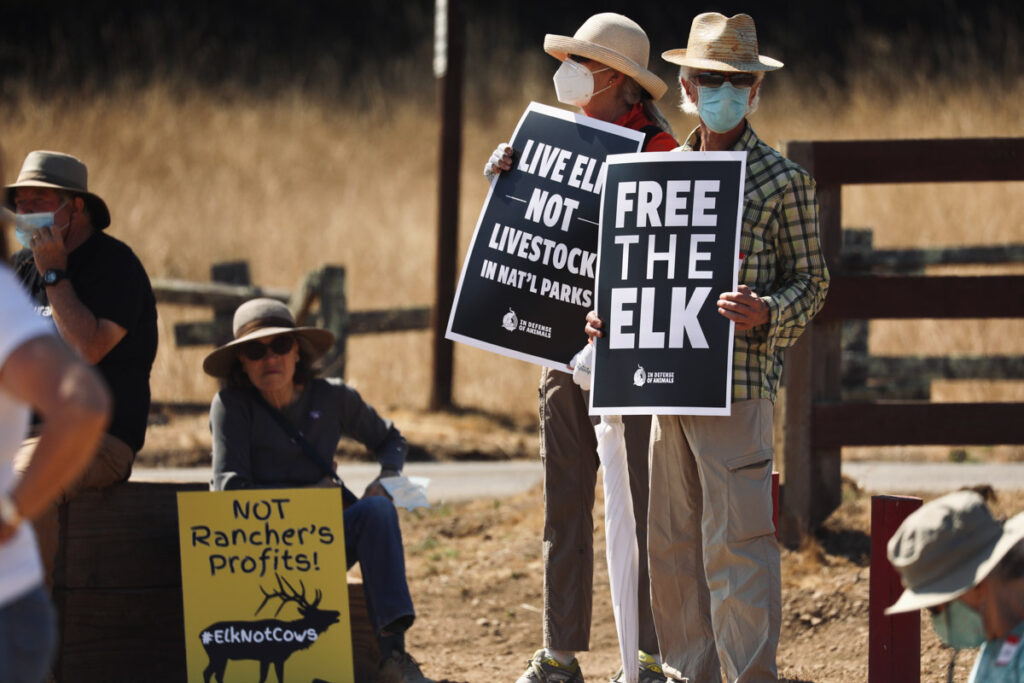
Large protests and rallies in and around the park have also been regular occurrences for many years now. Evidently, practically the only people who actually still support ranching in the park are the ranchers themselves and the politicians who stand to benefit financially from them. But although the overwhelming majority of the county’s residents would prefer for the ranchers to close up shop, the local politicians and the NPS have made it clear that the profits of the park’s handful of ranchers are more important than public interest.
Since the 1990s, the park’s ranches have been leased mainly on “letters of agreement,” which do not legally require Environmental Impact Statements (EIS) from the farms. Effectively, commercial agriculture has been allowed to continue in the national seashore for decades with no impetus to consider or monitor the environmental impacts on the park. But ranchers continue to push for increased power, and in 2014 the Point Reyes Seashore Ranchers Association sent a series of letters to the park service claiming that elk were knocking down their fences, eating valuable grasses, drinking up too much water, harassing cattle, and reproducing at an “alarming rate.” At this point, there were over 5,000 cattle in the park. The park’s elk population was 498.
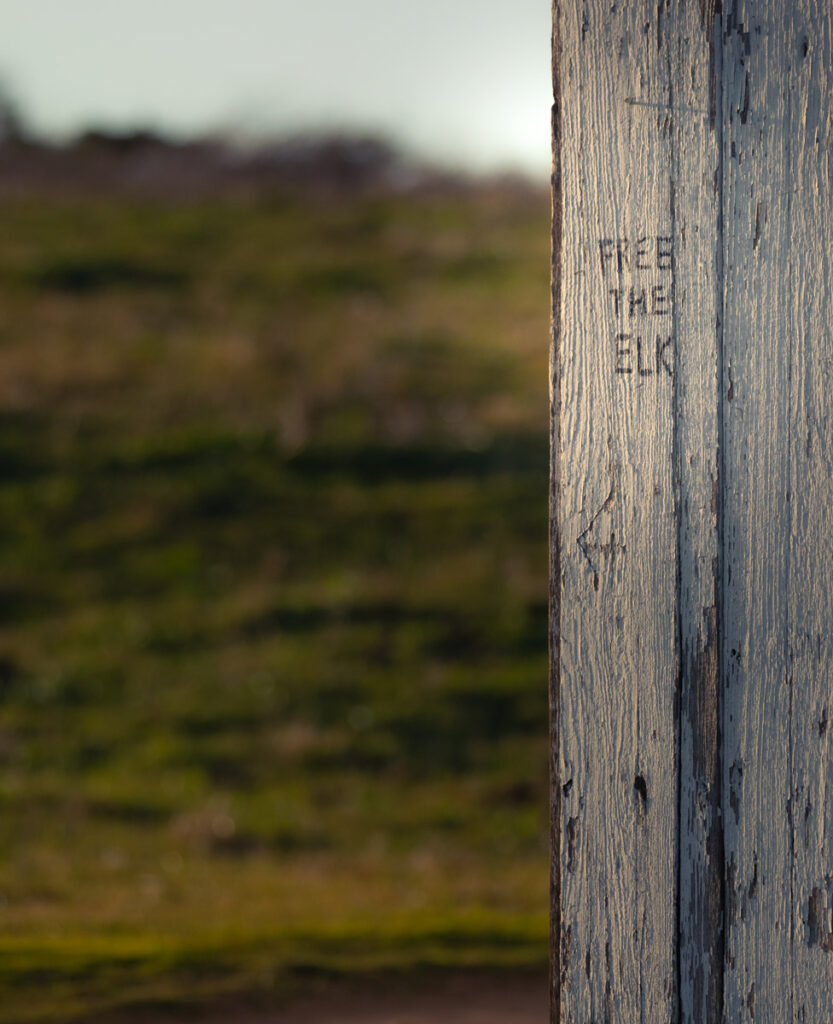
Congressman Jared Huffman, the district’s Representative, is widely considered to be an environmental hero. But his environmental criticisms have been largely aimed at coal and oil – two industries not heavily present in his district – a safe political strategy. In contrast, he has far more tolerance for large-scale commercial agriculture, which is widespread across his district. It is no surprise that Huffman, who has received 27% more congressional career donations from the agribusiness sector than from environmental interests, has spent the last several years working to prop up Point Reyes’s ranches, despite his constituency’s clear stance on the issue. In 2018, he even went so far as to introduce H.R. 6687, a bill co-sponsored by republican anti-public lands congressman Rob Bishop, which aimed to derail an environmental impact study on the ranching in Point Reyes and further transfer power within the park from the public to the ranchers. The bill failed to pass.
Similarly, the park service itself has also worked tirelessly to silence and disband any pro-elk movements, all while continuing to deny any wrongdoing with regards to the wellbeing of the park’s elk. For example, in 2019, the park reached out to its 2018 Volunteer of the Year, Dianna Oppenheim, who while volunteering regularly at the park had begun publicly expressing her support for the elk and her disapproval of the park’s ranches. The park’s volunteer coordinator ordered her to refrain from making such statements publicly. She refused, and the park has since banned her from volunteering.
But Oppenheim isn’t the only person who’s been dismissed by the park service.
The Coast Miwok people, Point Reyes’s original inhabitants, who lived alongside the region’s wild tule elk for several thousand years before European settlers arrived, and who have been vocal about protecting the tule elk, have also been repeatedly silenced by the park. In 2008, the park filed an application to deem Point Reyes National Seashore an Indigenous Archaeological District on the National Register of Historic Places. The proposal sat in bureaucratic limbo for almost a decade with no forward movement, until, in 2015, the park service quietly withdrew the Indigenous District nomination and replicated it with an application for a Historic Dairy Ranching District. This application was approved almost immediately – a gross display of the park’s eagerness to prioritize the park’s modern commercial agriculture over thousands of years of indigenous archaeology and biology. This confirmation created further federal tax credits for the park’s ranchers and continues to support their lease extensions, all under the guise of “historical preservation.” But Theresa Harlan, a Coast Miwok author and activist, reminds the park that prioritizing Point Reyes’s relatively young ranching history is predicated on the erasure of nearly 10,000 years of native and natural history.
AN ONGOING FIGHT
Today in Point Reyes National Seashore, nearly 6,000 beef and dairy cattle roam the grassy hillsides – approximately the same number of tule elk left in the world. The Tomales Point Herd remains fenced, while the Drake’s Beach Herd continues to await the implementation of Alternative B, which will establish the 140-individual herd cap and authorize the killing of dozens of elk by the park. Drought and other environmental factors continue to threaten the elk and other native species while politicians and the National Park Service continue to empower the park’s destructive commercial ranching operations. In the past decade, over 400 threatened tule elk have died at the park’s hands. Over the years, the signatures of over 100,000 concerned citizens and over 100 respected environmental organizations have been sent to relevant politicians and the park service petitioning for ranching be removed from the park. And although the park’s Alternative B was successfully passed, advocates continue to search for ways to fight for the elk’s right to exist peacefully within the national seashore.

For the month of June, 10% of every print sale will be donated to Western Watersheds Project, a nonprofit environmental organization that has been leading the fight to protect the tule elk of Point Reyes. Visit my shop page here.

For further resources on how to help the tule elk of Point Reyes, visit:
All photos by Lauren Bettino
SOURCES:
- NPS | PRNS General Management Plan 2020 Comments 1-5026
- NPS | PRNS General Management Plan 2020 Comments 5027-7624
- NPS | PRNS Releases 2020 Population Numbers of Tule Elk Across the Park
- Community Survey 2021
- NPS | Tule Elk Monitoring and Management at PRNS: 2015–2016 Report
- Official Joint Letter to California Coastal Coalition to Delay Confirmation of PRNS GMP
- Journal of Conservation Biology | Influence of a Large Herbivore Reintroduction on Plant Invasions and Community Composition in a California Grassland
- Journal of Soil and Water Conservation | Survey of Livestock Influences on Stream and Riparian Ecosystems in the Western United States
- Official Report | Point Reyes Surface Water Monitoring 27-28 Jan 2021
- Bay Nature | Home on the Range
- Bay Nature | Point Reyes: Planning or Performance?
- Bay Nature | Con: Cattle Grazing Is Incompatible with Conservation
- Sierra Club | The Curious Case of the Dead Elk at PRNS
- Sierra Club SF Bay | Captive Tule Elk Are Dying in Point Reyes
- Pacific Sun | Death by Design: How the National Park Service Experiments on Tule Elk
- Pacific Sun | Apocalypse Cow: The Future of Life at Point Reyes National Park
- Pacific Sun | Tamál Húye: Coast Miwoks Fight for Recognition of Point Reyes’ Indigenous History
- Marin IJ | Lawsuit: PRNS Negligent in Tule Elk Die-off
- Marin IJ | Point Reyes Ranch Inspections Find Sewage Dumping, Leaks
- Marin IJ | ‘Desecration’: Marin Tribal Descendants Oppose Point Reyes Plan
- Marin IJ | Huffman Stance on Ranching in PRNS is Vexing
- Marin IJ | Proposed Point Reyes Ranch Management Plan Fails Public
- Marin IJ | Elk Deaths in Point Reyes — The Tragedy Must Stop
- Marin IJ | Water Testing Must be Part of Point Reyes Plan
- SFGate | Activists are Sneaking Into Point Reyes to Give Thirsty Elk Water & Rangers Aren’t Happy About It
- Center for Biological Diversity | California’s Rep. Huffman Joins Anti-Public Lands Zealot to Evict Elk From Point Reyes
- Center for Biological Diversity | Rigorous New Study Finds Significant Water Pollution From Cattle Ranching at PRNS
- In Defense of Animals | Elk Activists Spur National Park Service to Action
- In Defense of Animals | National Park Service Bullies Coastal Commission on Behalf of Ranchers into Approving Tule Elk Firing Squad
- National Geographic | Unique Elk in California May Be Killed Under Controversial Plan
- Smithsonian Libraries and Archives | Managing a Land in Motion: An Administrative History of PRNS
- The New York Times | Roaming Elk at Point Reyes Bedevil Ranchers in California
- LA Times | As Fire Burns, Activists Sneak into Point Reyes to Bring Water to Parched Elk. Should They?
- Mercury News | State Rejects Point Reyes Water Contamination, Climate Plan
- Turtle Island Restoration Network | Rigorous New Study Finds Significant Water Pollution from Cattle Ranching at PRNS
- National Parks Traveler | Time To End Ranching At Point Reyes National Seashore
- HuffPost | U.S. Sued After 150 Fenced Tule Elk Die In California Drought
- SF Chronicle | At Point Reyes, the Contest is Elk vs. Agriculture. The People Vote for the Elk
- ABC News | ‘They are Threatened’: Protests Continue in Point Reyes as Tule Elk Controversy Heads to Federal Court
- Reuters | California Drought Causes Cattle and Elk to Lock Horns Over Pasture